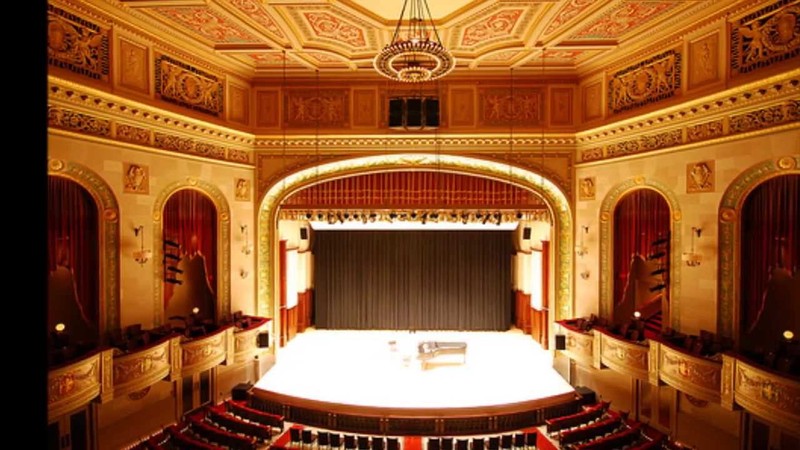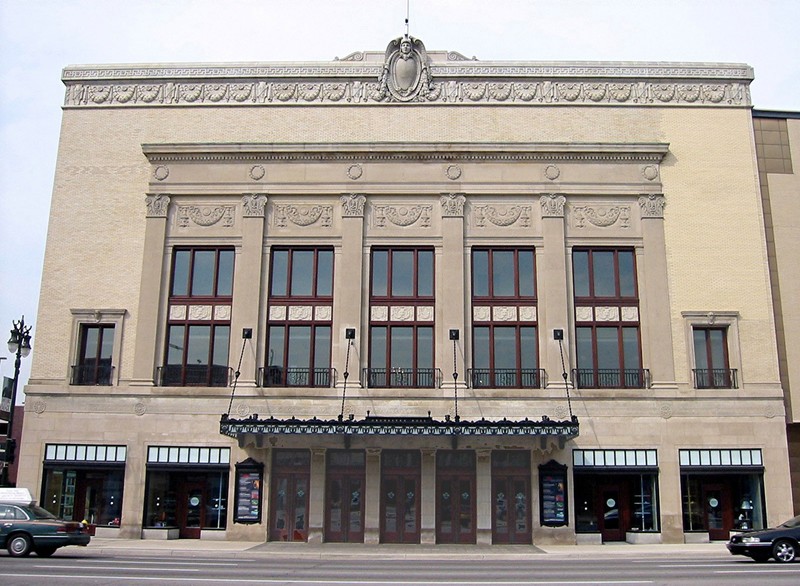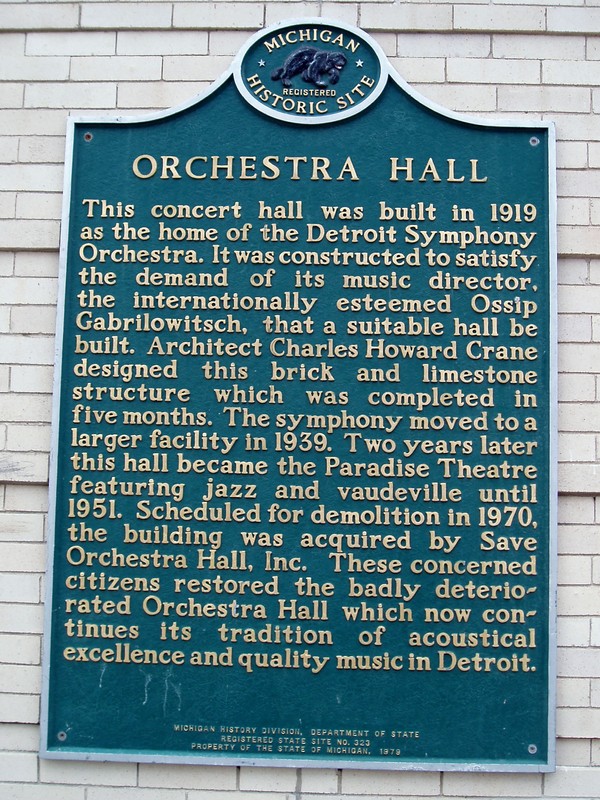Detroit Symphony Orchestra Hall
Introduction
Text-to-speech Audio
Images
Detroit Symphony Orchestra Hall (image from YouTube)

Orchestra Hall (image from Detroit: History and Future of the Motor City)

Orchestra Hall historic marker (image from Detroit: History and Future of the Motor City)

Backstory and Context
Text-to-speech Audio
History of the Detroit Symphony Orchestra and Orchestra Hall
On Monday, December 19, 1887, the Detroit Symphony Orchestra (DSO) performed for the first time. At that point, the symphony had no hall of its own, and played at the Detroit Opera House. Beginning in 1914, a group of ten women donated to and raised funds for the symphony and hired Bostonian organist Weston Gales as music director. By the time Gales left his position three years later, the orchestra had sufficient funds to bring in renowned Russian pianist Ossip Gabrilowitsch as the new director. Gabrilowitsch, the son-in-law of writer Mark Twain and friend of composers Gustav Mahler and Sergei Rachmaninoff, took the position on the condition that the Detroit Symphony Orchestra would be given its own hall. Eager to keep the acclaimed musician, the Detroit Symphony Society purchased the Westminster Presbyterian Church, demolished it, and began construction of Orchestra Hall partially on its foundations in April of 1919. Less than five full months later, the building was finished [1; 2].
The Beaux Arts style Orchestra Hall was designed by Detroit architect C. Howard Crane, and held its first concert on October 23, 1919. The Detroit Symphony Orchestra bloomed into one of the most noted orchestras in the United States. In 1922, the orchestra performed the first live radio broadcast of a symphony in the history of the world. Six years later, the DSO made its first recording and performed at Carnegie Hall in New York. During the 1920s and 1930s, musicians featured at Orchestra Hall in Detroit included Enrico Caruso, Igor Stravinsky, Richard Strauss, Marian Anderson, Sergei Rachmaninoff, Isadora Duncan, Anna Pavlova, Jascha Heifetz, Pablo Casals. The DSO became the first orchestra to be broadcast on nationwide radio in 1934, and held the distinction of being the first official national radio orchestra from that year until 1942. Unfortunately, the Great Depression of the 1930s left the DSO in financial crisis. Coupled with Gabrilowitsch's sudden death in 1936, the orchestra's troubles forced the DSO to give up Orchestra Hall. Once again, the symphony had no permanent home of their own, playing in various locations including the Detroit Opera House, the Masonic Auditorium, and Ford Auditorium [1; 2].
Orchestra Hall stood vacant until 1941, when it reopened as the Paradise Theater, owned by Ben and Lou Cohen. Paradise Theater showed movies and held performances by jazz, bebop, and blues musicians including Duke Ellington, Louis Armstrong, Lena Horne, and Pearl Bailey. After ten years as an acclaimed club, Paradise Theater closed in 1951, and four years later the Church of Our Prayer took up residence in the building. The Hall deteriorated during the 1960s and 1970s, while the orchestra maintained its reputation with 70 recordings in 11 years, as well as contributing to Motown songs. Despite the efforts of a non-profit group called Save Orchestra Hall in the 1960s, by the next decade the Hall was slated for demolition to make room for a department store parking lot. Paul Ganson, DSO bassoonist, led protest marches and organized benefit performances to save the Hall. Twenty years of restoration later, in 1989, the DSO held its opening concert in its old home. Since then, the Max M. Fisher Music Center (consisting of Orchestra Hall, Fisher Hall, The Music Box, and the Jacob Bernard Pincus Music Education Center) and the adjacent Detroit School of Arts public high school have been built. These facilities provide the orchestra with an additional performance hall (the Music Box), space for educational programs including Civic Youth Ensembles, practice and rental space, a Neighborhood Residency Initiative, and technology and broadcasting capabilities. In honor of the Hall's years as Paradise Theater, the DSO offers a Paradise Jazz Series. The DSO is also the only orchestra to offer free live webcasts of performances (available at http://dso.org/live) [1; 2].
Historic Marker Inscription:
MICHIGAN REGISTERED HISTORIC SITE / ORCHESTRA HALL / This
concert hall was built in 1919 as the home of the Detroit Symphony Orchestra.
It was constructed to satisfy the demand of its music director, the
internationally esteemed Ossip Gabrilowitsch, that a suitable hall be built.
Architect Charles Howard Crane designed this brick and limestone structure
which was completed in five months. The symphony moved to a larger facility in
1939. Two years later this hall became the Paradise Theatre featuring jazz and
vaudeville until 1951. Scheduled for demolition in 1970, the building was
acquired by Save Orchestra Hall, Inc. These concerned citizens restored the
badly deteriorated Orchestra Hall which now continues its tradition of
acoustical excellence and quality music in Detroit. / MICHIGAN HISTORY
DIVISION, DEPARTMENT OF STATE / REGISTERED STATE SITE NO. 323 / PROPERTY OF THE
STATE OF MICHIGAN, 1979 [1].
